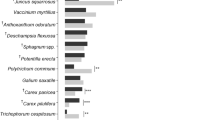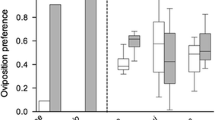Abstract
The sex ratio in final-instar larvae of a birch-feeding, free-living solitary sawfly, Dineura virididorsata, was investigated in Finnish Lapland. The prepupal proportion of females, pooled over ten sites, was 56%, and at four individual sites the sex ratio was significantly female-biased. Larval survival from egg to prepupae did not differ between the sexes. This suggests a femalebiased primary sex ratio in the field. The sex ratio varied among the sites but not among host trees within sites. Contrary to previous results with hymenopterans, we did not find that differences in the sex ratio depended on forage quality: site-specific or tree-specific sex ratios did not correlate with the average prepupal weight. A literature search indicated that female-biased sex ratios are also common in other free-living sawflies. We are unable to explain sex ratios of Dineura virididorsata or other free-living sawflies with existing general models.
Similar content being viewed by others
References
Bulmer MG (1986a) Sex ratio theory in geographically structured populations. Heredity 56: 69–73
Bulmer MG (1986b) Sex ratios in geographically structured populations. Trends Ecol Evol 1: 35–38
Caley JM, Nudds TD (1987) Sex ratio adjustment in Odocoileus: does local resource competition play a role? Am Nat 129: 452–457
Charnov EL (1979) The genetical evolution of patterns of sexuality: Darwinian fitness. Am Nat 113: 465–480
Charnov EL (1982) The theory of sex allocation. Princeton University Press, Princeton
Clark AB (1978) Sex ratio and local resource competition in a prosimian primate. Science 201: 163–165
Craig TP, Price PW, Itami JK (1992) Facultative sex ratio shifts by a herbivorous insect in response to variation in host plant quality. Oecologia 92: 153–161
Donaldson JS, Walter GH (1984) The sex ratio of Spalangia endius (Pteromalidae: Hymenoptera) in relation to current theory. Ecol Entomol 9: 395–402
Donaldson JS, Walter GH (1991a) Brood sex ratios of the solitary parasitoid wasp, Coccophagus atratus. Ecol Entomol 16: 25–33
Donaldson JS, Walter GH (1991b) Host population structure affects field sex ratios of the heteronomous hyperparasitoid, Coccophagus atratus. Ecol Entomol 16: 35–44
Fischer RA (1930) The genetical theory of natural selection. Oxford University Press, Oxford
Flanders SE (1965) On the sexuality and sex ratios of hymenopterous populations. Am Nat 99: 489–494
Hamilton WD (1967) Extraordinary sex ratios. Science 155: 477–488
Haukioja E, Niemelä P, Iso-Iivari L, Ojala H, Aro E-M (1978) Birch leaves as a resource for herbivores. I. Variation in the suitability of leaves. Rep Kevo Subarct Res Stat 14: 5–12
Haukioja E, Niemelä P, Sirén S (1985a) Foliage phenols and nitrogen in relation to growth, insect damage, and ability to recover after defoliation, in the mountain birch Betula pubescens ssp. tortuosa. Oecologia 65: 214–222
Haukioja E, Suomela J, Neuvonen S (1985b) Long-term inducible resistance in birch foliage: triggering cues and efficacy on a defoliator. Oecologia 65: 363–369
Herre EA (1985) Sex ratio adjustment in fig wasps. Science 228: 896–898
Herre EA (1987) Optimality, plasticity and selective regime in fig wasp sex ratios. Nature 329: 627–629
Juutinen P (1967) Zur Bionomie und zum Vorkommen der roten Kiefernbuschhornblattwespe (Neodiprion sertifer Geoffr.) in Finnland in den Jahren 1959–65. Comm Inst For Fenn 63: 1–129
Kangas JK (1985) Pälkäneen sahapistiäisfauna 1953–1983 (in Finnish) Pälkäne-Seuran julkaisuja nro 5
Koponen S (1973) Herbivorous invertebrates of the mountain birch at Kevo, Finnish Lapland. Rep Kevo Subarct Res Stat 10: 20–28
Mallach N (1974) Zur Kenntnis der Kleinen Kiefer-Buschhornblatt-wespe Diprion (Microdiprion) alipes (Fall.) (Hym., Diprionidae). Z Angew Entomol 75: 337–380
Myint WW, Walter GH (1990) The behaviour of Spalangia cameroni males in relation to sex ratio theory. Oikos 59: 163–174
Nadel H, Luck RF (1992) Dispersal and mating structure of a parasitoid with a female-biased sex ratio. Implications for theory. Evol Ecol 6: 270–278
SAS Institute (1985) SAS User's Guide: statistics, Version 5 edition. SAS Institute, Cary, North Carolina
Tepedino VJ, Torchio PF (1982) Temporal variability in the sex ratio of a nonsocial bee, Osmia lignaria propingua: Extrinsic determination or the tracking of an optimum? Oikos 38: 177–182
Thalenhorst W (1941) Zur Prognose des Schadauftretens der Kiefernbuschhornblattwespe (Diprion pini L.). Z Forst Jagdw 73: 201–246
Walter GH, Ruohomäki K, Haukioja E, Vainio E (in press) Reproductive behaviour of mated and virgin females of a solitary sawfly Dineura virididorsata. Entomol Exp Appl
Wellings PW, Morton R, Hart PJ (1986) Primary sex-ratio and differential progeny survivorship in solitary haplo-diploid parasitoids. Ecol Entomol 11: 341–348
Vikberg V (1970) The genus Pontania O. Costa (Hym., Tenthredinidae) in the Kilpisjärvi district, Finnish Lapland. Ann Entomol Fenn 36: 10–24
Author information
Authors and Affiliations
Rights and permissions
About this article
Cite this article
Ruohomäki, K., Haukioja, E. & Walter, G.H. Resource quality and spatial variation in sex ratios of a free-living solitary sawfly, Dineura virididorsata (Hym., Tenthredinidae). Oecologia 96, 420–425 (1993). https://doi.org/10.1007/BF00317514
Received:
Accepted:
Issue Date:
DOI: https://doi.org/10.1007/BF00317514




